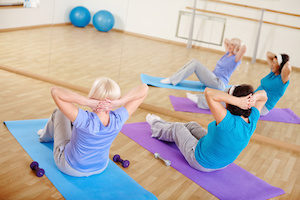
Sit-ups seem to be the go-to exercise when someone wants to ‘get abs’ or lose some weight from around the middle!
Recent research, however, has led sit-ups to fall out of favour with many members of the health and fitness industry over concerns they may be doing more harm than good.
The US Army actually trialled a revamped physical fitness test and eliminated sit-ups from the programme after a study of 1500 army soldiers found 56% of injuries associated with their previous testing programme were attributed to sit-up exercises1.
As a physiotherapist, I am often asked if sit-ups are a worthwhile exercise to do. Let’s explore that question…
Which muscles are working when you do a sit-up?
The traditional military sit-up involves lying with your knees bent and while someone holds your feet, and you bring yourself up to a seated position until your hips are flexed to a 90° angle. Your abdominal muscles (in particular your rectus abdominus which reaches from your ribs to your pubic bone) and your hip flexors (muscles at the front of the thigh) are the key muscles that are activated during a sit-up exercise.
Our abdominal muscles have two roles: bracing the body e.g. when we push, pull, throw, lift; and linking the upper and lower body to transfer power. Neither of these purposes are replicated during a sit-up exercise which makes sit-ups a relatively ineffective option for training the abdominals.
Will doing sit-ups regularly give me a ‘six pack’ of abs?
It’s definitely a myth that you can achieve a flat tummy by doing sit-ups! You cannot ‘spot reduce’ fat from your mid-section – only implementing a sound nutritional plan and a comprehensive exercise programme, including cardiovascular conditioning and strengthening, will achieve that! In a 2011 study, a group of participants who completed two sets of ten sit-ups, five days a week for six weeks, had no change in body fat percentage, body weight or waist circumference compared to a group who did no exercise. Both were consuming the same number of calories per day2. The exercise group were able to perform more sit-ups when retested than the non-exercise group were, showing some improvement in muscular endurance, however we know that there are alternative core exercises which involve significantly greater activation of the abdominal muscles e.g abdominal rollouts (holding a swiss ball, barbell or dumbbell in front of you and with your body facing the floor, rolling forward to balance with the hips off the floor) than sit-ups do. For this reason, if you are aiming to build better abdominal endurance the sit-up is not the best option.
The ability to gain a ‘six pack’ appears most likely to come down to your percentage of body fat, and your genetics (as everyone’s abdominal tendons develop differently), rather than correlating with the volume of sit-ups you perform! Consider dancers and gymnasts, who often have flat stomachs – they perform a variety of whole body movements, and have excellent awareness of their own posture. This allows them to achieve great shape and tone of the tummy. They are not likely to ever be doing sit-ups!
Is there a risk of injury if I do sit-ups?
The relative ‘danger’ in performing sit-ups is related to large compressive forces which are exerted on the spinal discs with repetitive flexion (bending) forces on the spine as is involved with completing sets of sit-ups. Over time this repeated compression may lead to lower back pain or injury. If you are doing a low number of repetitions of a sit-up, then your risk of injury is likely low. If you have had previous lower back injuries your risk may be higher. The old adage of ‘no pain, no gain’ is not a good one. If you are experiencing pain while completing abdominal exercises you should consult a health or exercise professional to check your technique and to ascertain whether your programme of exercises is right for you.
In addition to considering potential injury to the lower back, we also know that each time you perform a sit-up, downward pressure from your abdominal contents puts strain on the pelvic floor. Doing this repetitively may not be an issue if your pelvic floor muscles are strong and able to cope with the extra pressure, however, if you consider yourself to have a weak pelvic floor, sit-ups are definitely something you want to avoid!
Muscle balance is also essential when you are exercising so if you solely focus on training the abdominals and neglect other parts of the body e.g. the gluteals, then you are more likely to become injured. It is important your fitness programme is targeting more than just one of your major muscle groups.
So should I do sit-ups?
There are more effective, potentially safer abdominal exercises you can perform so my suggestion is to skip the sit-ups: try planks, side-planks, or bird-dog exercises instead and focus on slow controlled movement which will develop endurance over fast reps and many sets. Research has shown that a modified crunch is an effective way to activate your abdominal muscles without overloading the lower back3. In a modified crunch you lie on your back with the knees bent and maintain a neutral spine position i.e. place a hand in the small of your back to ensure your back is supported and not caving into the floor. Then lift your head and shoulders a few inches from the ground and hold yourself there while keeping your back from flattening to the floor, controlling your breathing for five to ten seconds. Clinical Pilates and swiss ball exercises are other good ways of developing better core strength without risking injury if instructed by an appropriately qualified health or fitness professional.
References
- Evans et al (2005). Incidence of acute injury related to testing of US Army Personnel. Military Medicine, 170, 12.
- Vispute et al (2011). The effect of abdominal exercise on abdominal fat. Journal of Strength & Conditioning Research, 25, 9, 2559-2564.
- McGill, S (1998). Lower back exercises: evidence for improving exercise regimes. Physical Therapy, 78, 7.








